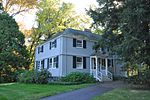Good Samaritan Medical Center (Brockton)
1968 establishments in Massachusetts2024 mergers and acquisitionsBrockton, MassachusettsHospitals in Plymouth County, MassachusettsSteward Health Care ... and 3 more
Trauma centersUse American English from October 2024Use mdy dates from October 2024
Good Samaritan Medical Center is a mid-size non-profit acute-care hospital located in Brockton, Massachusetts with auxiliary facilities in the neighboring town of Stoughton. Good Samaritan's is a part of Boston Medical Center Health System, a non-profit health care system which took over the hospital in 2024 from Steward Health Care, its previous operator, which was forced to sell its Massachusetts hospitals following its bankruptcy.
Excerpt from the Wikipedia article Good Samaritan Medical Center (Brockton) (License: CC BY-SA 3.0, Authors).Good Samaritan Medical Center (Brockton)
North Pearl Street, Brockton
Geographical coordinates (GPS) Address Phone number Website Nearby Places Show on map
Geographical coordinates (GPS)
| Latitude | Longitude |
|---|---|
| N 42.097731 ° | E -71.062564 ° |
Address
Good Samaritan Medical Center
North Pearl Street 235
02301 Brockton
Massachusetts, United States
Open on Google Maps







